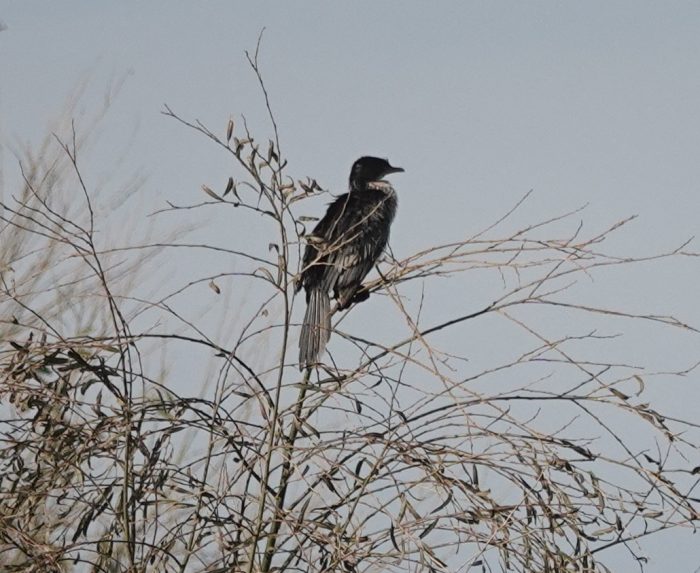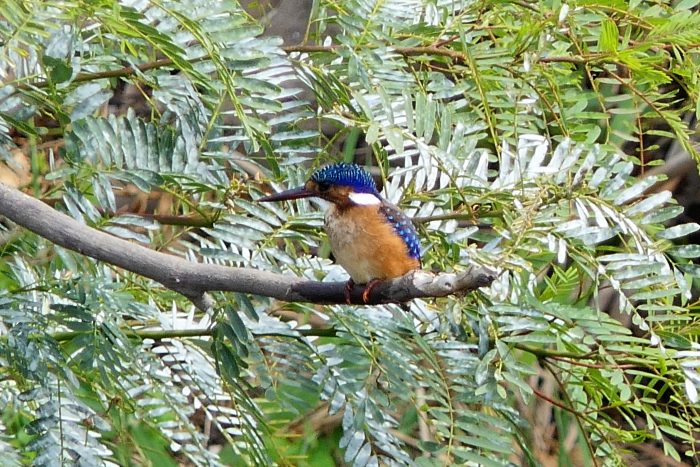Having started out in life on the eastern buttress of Table Mountain, the Liesbeek River loses its freedom and is condemned to run most of its course imprisoned in a concrete canal. It is liberated for a kilometre or so as it passes through the Cape Town suburb of Observatory. Biodiversity does its best to flourish in this section. The focus here is mainly on one component of that biodiversity, the birds.
In the mornings, the best place to bird is on the east bank, with the sun behind you. The road on this side runs alongside Valkenberg, and ends at the Wild Fig restaurant. In the afternoons, there is parking opposite the Hartleyvale sportsfields. There are lots of people out walking and jogging, some with dogs and some with binoculars.
Among the first species you ought to see on the river and in the vegetation along the edges are Yellow-billed Duck, Common Moorhen and Reed Cormorant. Because the river is not wide, and because the birds are, to some extent, habituated to the presence of people, you get to see them close up. This is part of what makes this wetland, insignificant in the grand scheme of things, so good for birding!



There are lots of species that you cannot expect to see on every visit to this piece of the Liesbeek River. African Black Ducks tend to be shy and swim away. Little Egrets are regular.



Birding is an activity that does not suffer from the law of diminishing returns. The greatest rewards go to those who spend the extra 10 minutes quietly at a spot waiting for the action. At this spot, you need to be continuously alert for the blue flash, aka the Malachite Kingfisher. If you are lucky, you can follow the flight to where it perches; but it often disappears out of sight.

The birds are not only on the river, but also above it. The airspace over the river is an avian highway, used as a navigational guide. Much of the overhead traffic consists of Hartlaub’s Gulls. Other species that pass by are Hadada Ibises, Pied Crows, and the occasional Kelp Gull.

From time to time, inspect the four floodlight towers around the main hockey field. Occasionally, there are used by raptors such as the Lanner Falcon. There are no photos to illustrate this behaviour in BirdPix, and the best we can do right now is this Rock Dove on the floodlights of one of the minor hockey fields.



In terms of keeping a watchful eye over the Liesbeek River, the pivotal group is the Friends of the Liesbeek. This volunteer group “aims to create an awareness of the importance of the Liesbeek River as a green corridor in an urban setting and to rehabilitate, enhance, and conserve it and its environs.” The website of the Friends of the Liesbeek has sections on the history of the river and good discussion of the river’s ecology. The general lack of litter in the river is attributable to one of the key initiatives of the Friends, the Liesbeek Maintenance Project.
For a year in 2020/21, the Cape Bird Club undertook bird counts along this lower section of the Liesbeek River, as far as the confluence with the Black River. There is a report on these counts in the club’s magazine, Promerops, in the July 2022 issue (you need to scroll down to page 22 to read the report of the counts).
Bird List
This list of species is based mainly on the photographic records in the BirdPix section of the Virtual Museum. A few species (e.g. Greater Flamingo and Fort-tailed Drongo) have been omitted because they are not species you can realistically expect to encounter here. In an hour’s visit, you can hope to see about half of the 30 species listed here, and most of them you will be able to see within twenty metres! The species with links have BDI descriptions. These species texts have headings such as Identification, Habitat, Distribution, Breeding, in that order.
Cape Canary – reeds and edges
Levaillant’s Cisticola – reedbeds
Red-knobbed Coot – river
Reed Cormorant – feeds in the river, and sits and dries its wings, on the islands in the river and on trees
Pied Crow – mostly flying over
Red-eyed Dove – lawns and trees
Rock Dove – lawns and trees
African Black Duck – river
Yellow-billed Duck – river, and resting on islands
Cattle Egret – lawns and banks
Little Egret – feeds in shallow water
Southern Fiscal – trees
Egyptian Goose – river, and resting on islands and the banks
Helmeted Guineafowl – banks and lawns
Hartlaub’s Gull – flying over, using the river as guideline, feeding in river, resting on islands and banks
Grey Heron – in the river
African Sacred Ibis – flying over, sometimes in the river
Hadada Ibis – flying over, noisily, and feeding on the lawns
Giant Kingfisher – along the river
Malachite Kingfisher – along the river, especially the quiet places
Pied Kingfisher – along the river, often hovering
Blacksmith Lapwing – on the banks and islands
Bronze Mannikin – new arrival, in the vegetation along the banks
Common Moorhen – in the river, often disappearing into the reeds
Black Sparrowhawk – trees
African Spoonbill – in the river
Common Starling – anywhere
Red-winged Starling – on the lawns and in the trees
Cape Wagtail – muddy edges and lawns
Cape Weaver – nests in the trees and reedbeds
This is not a comprehensive list. There are Cape White-eyes in the trees, and warblers in the reedbeds!
Otters
This remarkable sighting comes from the Facebook group of the Friends of the Liesbeek, posted in 2018!
If you are exceptionally lucky, you can see a Cape Clawless Otter here. Sue Kingma’s text perfectly captures the significance of this awesome observation.
Even though this record was made six years ago, otters do still occur along the river. The challenge is having a camera at the ready!

Dragonflies and damselflies
The OdonataMAP section of the Virtual Museum has 47 records of dragonflies and damselflies from along the Liesbeek River, with six species in this section of the river (Blue Emperor, Red-veined Dropwing, Cape Skimmer, Broad Scarlet (photo below), Mountain Sprite, Tropical Bluetail). That will be a topic for a blog in summer, when these insects are active.

Thanks
Sharon Stanton, Heleen Louw, Jean Ramsay and Kevin Winter helped in assembling concepts and photographs. Thank you.

